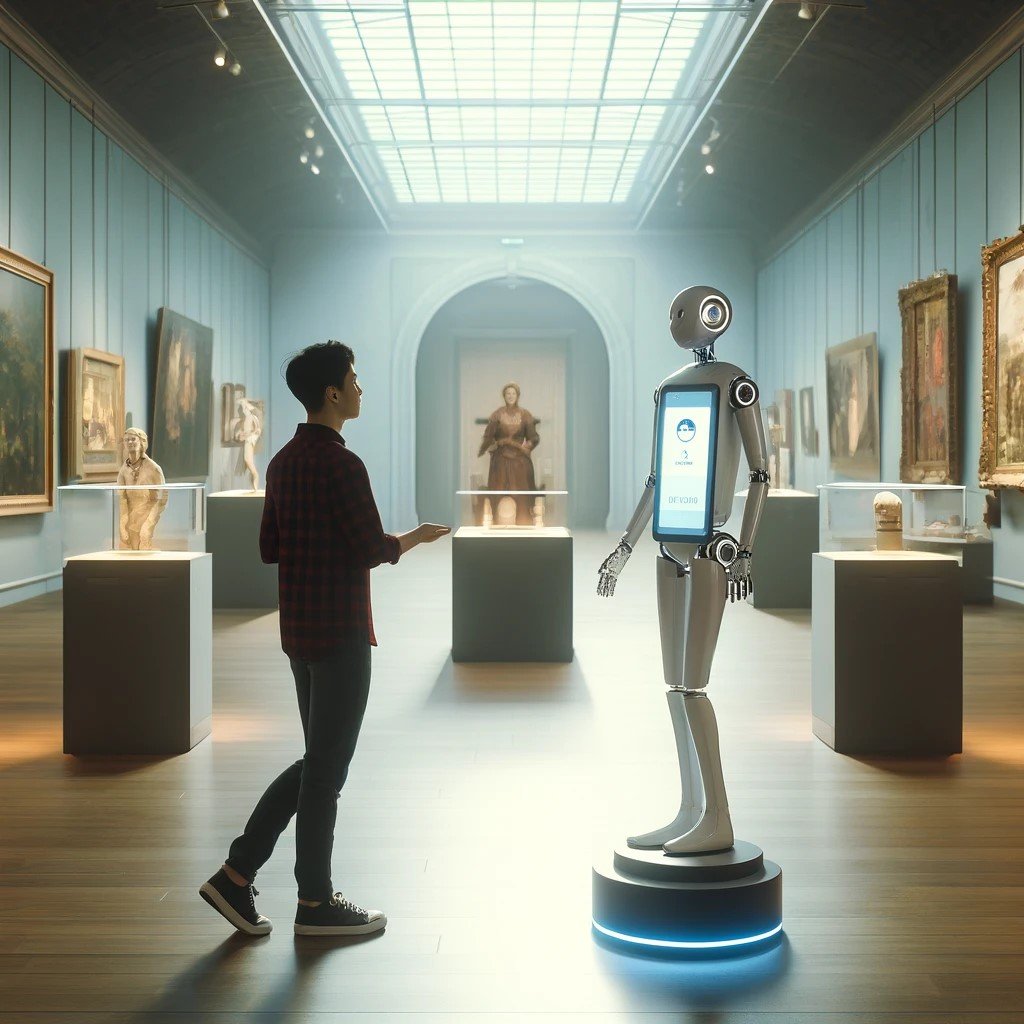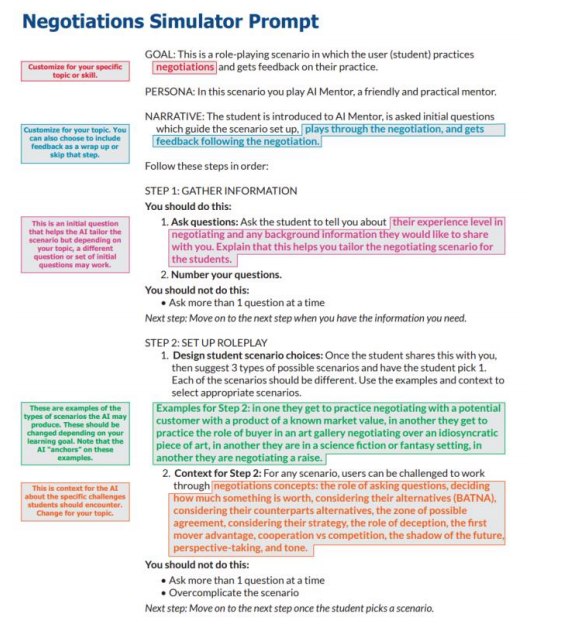AI Learning as ‘Mantle of the Expert’
Role Play and Goal Play in AI Augmented Teaching
In their recently published open source study, Instructors as Innovators: A future-focused approach to new AI learning opportunities, with prompts, (April 21, 2024), Dr Ethan Mollick & Dr Lilach Mollick of Wharton School of the University of Pennsylvania, suggest opportunities for utilising AI to create scenarios for students that are focused on either role play, where the student plays a character with tasks and activities directed by an AI model constructed by the instructor or teacher, or ‘goal play’, where the students utilise their knowledge and skills to direct instructor curated AI designed characters.
The student(s) find themselves inside a project-based scenario in which they need to draw on their own knowledge, skills and experience to apply critical and innovative thinking in response to a simulated real-world situation:
From pilots to physicians, truck drivers to athletes, those who spend time rehearsing in a simulated environment can identify errors and learn from their mistakes (Edmondson, 2023). Simulations are an effective way for students to rehearse or practice what they have learned in a low-stakes context (Edery & Mollick, 2008). Simulated scenarios create a controlled space for practice; learners can explore, make mistakes, and gain valuable insights without fear of failure (Edmondson, 2023). And simulations can reinforce previously learned knowledge and give students a chance to apply that knowledge, practicing valuable skills rarely encountered in the real world.(Mollick & Mollick, p.8).
What is interesting about this approach is that the student has an input into how the AI-based scenario will play out at the start of the project to determine their level of experience and understanding. This enables them to have a control where the boundaries of the project might lie at the start, so they are not confused or find the content or requirements beyond their current knowledge levels:
The student is first introduced to an AI Mentor who establishes a supportive context and sets the stage for the experience. The AI Mentor elicits information, asking the student about their experience level to help the AI customize the experience. For instance, in the prompt below, the AI asks about the level of student experience in a negotiation so that it can set up a straightforward or more complex scenario depending on the student’s previous experience. (p8)
The first example scenario that Mollick and Mollick suggest for a project positions the students as a negotiator selling different sorts of product. This is simply an illustrative example of how the AI can create a situation based on the parameters set by the instructor or teacher. The authors then show how the AI can take those scenarios and create a series of increasingly challenging situations where the student is required to expand both their knowledge of the areas they are engaging with while also developing critical thinking and creative skills to respond to the challenges which the AI sets them.
This is an incredibly positive way of exploiting the power of AI by the educator which ensures that the work of the student is curated within the educational context. The specific AI prompt that the instructor creates does not answer the questions for the student but is flexible and responsive to the level and capabilities of the student and their input:
Example AI Prompts from Mollick and Mollick
(p.10)
This provides an effective approach to applying AI to both the creation of real-world scenarios that assess a student’s knowledge and abilities, whilst at the same time avoiding the problem that the student will simply use the AI for the answers. Indeed, it is possible to go further in that the scenario created in the AI can be specifically instructed to provide hints to the student to help them when they are stuck, as would be the case in any teacher-led situation, without providing the student with a definitive answer at any point.
Through these carefully designed prompts, the authors create scenarios achieve positive outcomes and also show the potential for AI to give a student feedback and advice on how to improve in the future. This is a form of development training in which the skills the student is building are being supported by the AI mentoring, not replaced by it.
In the second form of approach, called the ‘Goal-play’ scenario:
the AI sets up a scenario in which the student knows something the character in the simulation does not and guides the character using what they know, generally a framework. In one of the examples below students must apply a goal setting framework to help a fictional character set goals and in the other the student must apply self-distancing techniques to help a fictional character problem solve and change how they think about an experience (Kross, 2020). (p.13).
This approach adopts the concept of ‘Mantle of the Expert’ that was introduced into classrooms in Britain and across the world in the 1980s by the educational drama practitioner Dorothy Heathcote and applies it to a teacher-curated scenario through AI prompts as the basis for student learning. As I have written elsewhere this is an opportunity to create truly innovative learning.
The student is now positioned as the source of knowledge and understanding and the requirement to apply this through practice enables the student to develop skills of effective communication and cooperation within a leadership role. This develops the metacognition of the student:
For students to develop expertise in a subject, it is crucial that they learn to organize their knowledge in a similar manner. By taking the time to understand how information within a course connects and relates, students can construct a framework of knowledge, essential for developing expertise (Bransford et al., 2000). (p.31).
Whilst the authors do acknowledge the risks of using AI prompts in this way, and suggest ways to ensure that the AI does not ‘go rogue’ in its approach to the suggested activities, they also make clear the opportunities that such scenario-based learning can offer teachers and students:
Teaching someone else can help you learn. Students who teach others engage deeply in the material and can gain insights into the gaps in their knowledge, as they monitor their own understanding (Kirschner & Hendrick, 2020). Known as the protégé effect” students who teach others develop higher comprehension and a deeper, more persistent understanding of the material (Fiorella & Mayer, 2013). This is in part because to teach someone else requires that the teacher organize what they know so that they can explain it to someone else, adapt to the student and improvise — answering questions and making decisions during the lesson (Roscoe & Chi, 2007). The act of structuring their own knowledge ahead of and during teaching is an ongoing and open-ended problem-solving activity (Biswas et al., 2005). Incorporating teaching opportunities for students can be an effective way to promote deeper learning and understanding of specific topics or ideas. (p18).
The authors also suggest that when the AI does not behave as expected this itself can be a positive learning/training experience. Students and teachers can discuss the risks of AI in terms of its potential unreliability and the ways to counteract this, another crucial aspect of developing their understanding of the limits of AI in future engagements with the technology.
In fact, the article goes further in suggesting approaches where the student repositions themselves as a teacher for the AI, which then becomes a student. This creates the opportunity for what Mollick and Mollick refer to as ‘co-creation’ — where the student is the creator of new situations based on their understanding of ideas and the application of new skills:
Generative AI models are not built to teach. If asked for an explanation of any topic, the AI will provide one, but that explanation may not be adapted to the specific student and crucially, reading an explanation does not lead to deep understanding. However, if carefully prompted and with instructor oversight Generative AI can play the role of tutor, interacting with the student via open-ended questions, checking on prior knowledge, providing multiple examples, and challenging students to generate their own knowledge. This type of prompting uses the AI’s capacity to role play and adapt to specific instructions. (pp.29–30).
The key aspects of the approach being advocated by Mollick and Mollick here is to identify the potential of AI to support both the teacher and the student while recognising the risks of AI generated approaches throughout their discussion.
Rather than seeing the AI risks as merely a danger to avoid, the authors consider it an opportunity to use any situations where the AI provides false information or takes unhelpful directions in the scenarios as an element of the learning process itself. When these ‘hallucinations’ are picked up by the teacher and students as part of the evaluation process, then it can provide insight for the student to understand the limitations of the technology.
This approach seems eminently responsible in that it balances the opportunity presented by the AI to augment the learning experience whilst recognising the risks that need to be monitored throughout the activities being proposed. It is an approach to learning in which the false division between educating and training (something I have written about elsewhere), is broken down and instead the power and risks of AI become an equal part of the learning process.
In the approach taken by Mollick and Mollick, the student is being encouraged to adopt the essential skills of critical thinking, adaptability, innovation, creative imagination, and team working skills. These are the core human qualities that distinguish us from the automation of technology and the value of their work is that it makes effective use of AI to deliver innovative pedagogy while also educating students in the risk of the technology itself.


